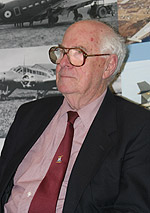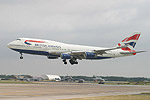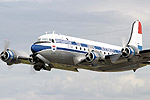Home | Airshows | The Hangar | Nostalgia | Links


|
JOHN
CRUICKSHANK VC attended RIAT on the same day that, 59 years
before, he displayed the tremendous courage that earned him the
highest medal awarded by the Armed Forces for gallantry
|
 |
|
On 17 July 1944, flying a Consolidated Catalina of 210 Squadron north of the Arctic Circle, Fit Lt Cruickshank, aged 24, and his crew attacked the German U-boat U-347. Regardless of the severity of the flak, he made a second attack and despite the death of' his Navigator and in drifting fog, he positioned six depth charges with devastating effect. The U-boat sank immediately but Cruickshank was severely injured. Having collapsed from his wounds after the attack, he regained command and set course for Sullom Voe in the Shetlands. Drifting in and out of consciousness throughout the return flight of almost six hours and losing much blood he assisted the co-pilot with the landing and was found to have an astounding 72 wounds. He is one of four Coastal VCs awarded during World War Two - the other three were awarded posthumously. John Cruickshank, 83, was born on May 20 1920. He joined the TA (Royal Artillery) before the Second World War and was called up in August 1939. His father did not want him to volunteer for flying so John waited until he was 21 and transferred to the RAF, All of his service was with Coastal Command. When the war finished, he was demobbed and went back to banking. |
|
Concorde
canx
|
 |
| It may have been splashed over all the pre-show publicity material, but sadly Concorde was cancelled by British Airways and substituted with a Boeing 747-400, carrying passengers on a charter flight from Heathrow. On what would have been its last Fairford appearance, the supersonic airliner would have been a star attraction - let's hope that the BA management have a change of heart and let Richard Branson have them all! |
|
Old
timers
|
 |
 |
|
Part
four : 100 years
|
Part three - Themes, tributes and exotica
Gary Parsons looks at the other attractions aviation-wise
|
Maritime
masters of Ocean Watch
|
 |
 |
 |
 |
 |
 |
 |
 |
|
PC
correctness
A
variety of Pilatus products could be seen at Fairford - PCs of every
description!
|
 |
 |
 |
 |
|
Heavy
mob
|
 |
 |
 |
 |
 |
 |

Ocean Watch was the main theme of the static park, other than the 100 years of flight exhibition (of which more next week). Ocean Watch paid tribute to the maritime aircrew through the ages, those that flew search and rescue missions, combat and anti-submarine patrols, reconnaissance and photographic missions, humanitarian aid drops, drug and illegal arms smuggling patrols to meteorological flights.
 RIAT
2003 also paid tribute to RAF Coastal Command on the 60th anniversary
of the Battle of the Atlantic, a campaign that was key to Allied victory
in the Second World War. Project 'Constant Endeavour', a series of presentations
and exhibitions at schools, colleges and other centres of learning was
launched at the event by the the RAF's sole surviving holder of the Victoria
Cross, Flight Lieutenant John Cruickshank. 'Constant Endeavour' will also
see a sculpture installed in Westminster Abbey as a memorial to the 9,000
lives lost in Coastal Command.
RIAT
2003 also paid tribute to RAF Coastal Command on the 60th anniversary
of the Battle of the Atlantic, a campaign that was key to Allied victory
in the Second World War. Project 'Constant Endeavour', a series of presentations
and exhibitions at schools, colleges and other centres of learning was
launched at the event by the the RAF's sole surviving holder of the Victoria
Cross, Flight Lieutenant John Cruickshank. 'Constant Endeavour' will also
see a sculpture installed in Westminster Abbey as a memorial to the 9,000
lives lost in Coastal Command.
Test pilots
Many test pilots were on hand over the weekend as RIAT paid a small tribute to the Empire Test Pilots School, based at Boscombe Down in Wiltshire. Formed in 1943, naturally this year is its 60th anniversary and so many famous names were around to meet the public, especially in the 100 years of flight arena. Famous names such as Peter Twiss, John Farley, Eric 'Winkle' Brown mixed with their modern-day counterparts, less weel-known but just as invaluable - Chris Yeo (fly-by-wire Jaguar), and Flt Lt Steve Austin (UK's youngest test pilot) (and no $6m jokes, please).
 Coalition
aircraft
Coalition
aircraft
In a tribute
to the thousands of men and women who served in The Gulf, some of the
aircraft used by the US, UK, Australian and Canadian air arms were on
show. No F/A-18s admittedly, but plenty of Tornados. RIAT Director Paul
Bowen said: "it is generally agreed that the Combined Forces Air
Component performed their task with great skill, teamwork and accuracy.
This was  achieved
because some of the world's most highly trained air and ground crews were
operating some of the most hi-tech aircraft in existence. Our aim is to
recognise the skills and professionalism that were involved in pulling
together each air arm's particular strengths into one single, highly effective
Coalition force."
achieved
because some of the world's most highly trained air and ground crews were
operating some of the most hi-tech aircraft in existence. Our aim is to
recognise the skills and professionalism that were involved in pulling
together each air arm's particular strengths into one single, highly effective
Coalition force."
Gulf Aircraft
Facts:
* Coalition air arms flew a total of 41,404 sorties in The Gulf during
the recent conflict.
* Of the 1,801 aircraft that flew or offered operational support, 1,663
came from the US, 133 came from the UK, 22 from Australia and 3 from Canada.
|
Exotica
|
|||
 |
 |
 |
 |
 |
 |
 |
 |
 |
 |
 |
 |
 |
 |
 |
 |
|
Whether
it's a fancy paint job or a rare treat, here's our pick of the static
parks
|
|||
Home | Airshows | The Hangar | Nostalgia | Links